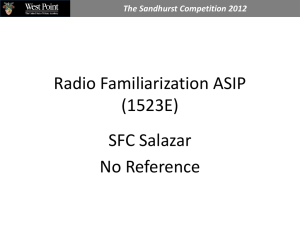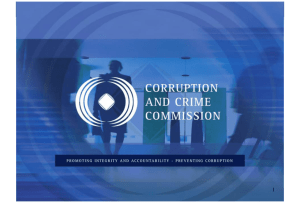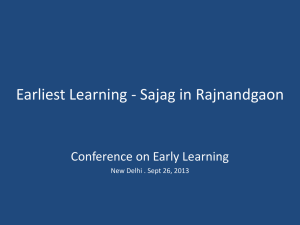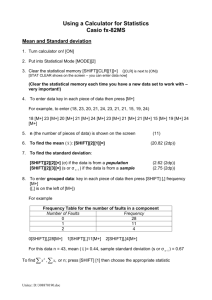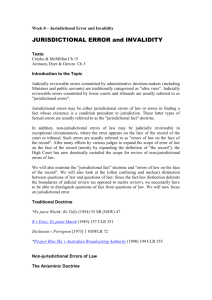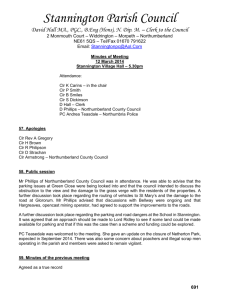Subject Guide - The University of Sydney
advertisement
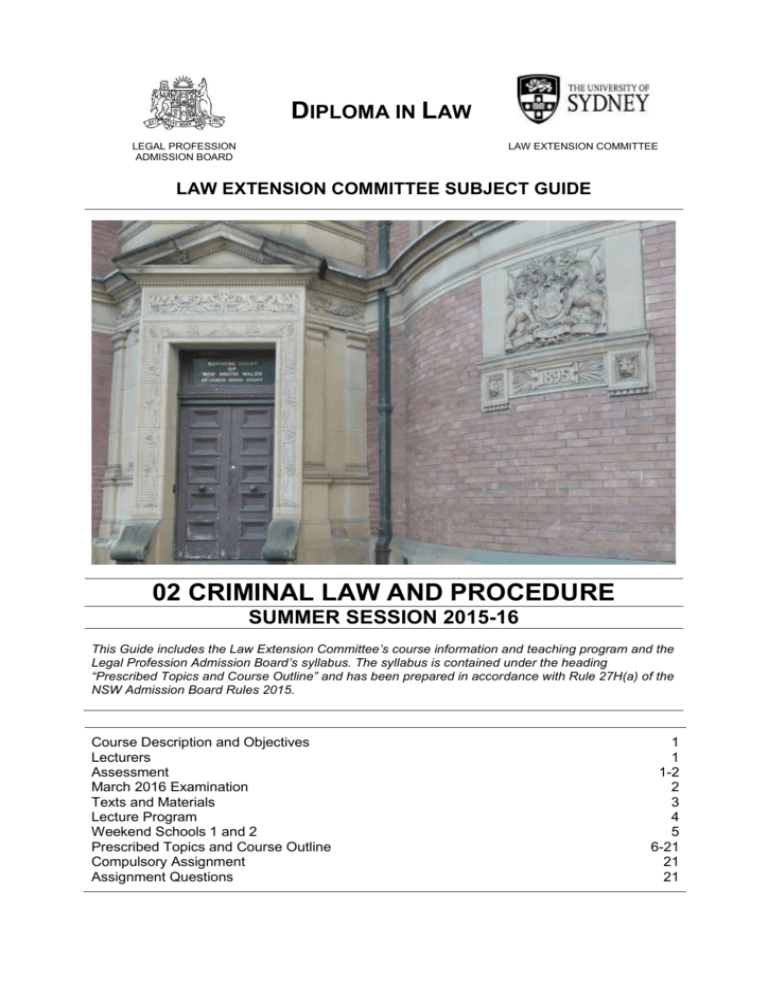
DIPLOMA IN LAW LEGAL PROFESSION ADMISSION BOARD LAW EXTENSION COMMITTEE LAW EXTENSION COMMITTEE SUBJECT GUIDE 02 CRIMINAL LAW AND PROCEDURE SUMMER SESSION 2015-16 This Guide includes the Law Extension Committee’s course information and teaching program and the Legal Profession Admission Board’s syllabus. The syllabus is contained under the heading “Prescribed Topics and Course Outline” and has been prepared in accordance with Rule 27H(a) of the NSW Admission Board Rules 2015. Course Description and Objectives Lecturers Assessment March 2016 Examination Texts and Materials Lecture Program Weekend Schools 1 and 2 Prescribed Topics and Course Outline Compulsory Assignment Assignment Questions 1 1 1-2 2 3 4 5 6-21 21 21 1 LAW EXTENSION COMMITTEE SUMMER 2015-16 02 CRIMINAL LAW AND PROCEDURE COURSE DESCRIPTION AND OBJECTIVES This course provides the student with an understanding of the general principles of criminal law, together with a detailed knowledge of the application of these principles in respect of major crimes. The student is also introduced to aspects of pre-trial criminal procedure, including police powers of arrest, search, seizure and interrogation. The objectives of the course are: (a) (b) (c) (d) to introduce students to aspects of pre-trial criminal procedure with a view to appreciating the competing public policy considerations of crime control and individual liberty; to provide students with a basic understanding of the general principles of criminal responsibility through an appreciation of criminal law theory, and the study of major crimes and defences; to develop the students’ skills of critical appraisal of social institutions and community values and expectations in relation to criminal behaviour; and to encourage students to think about the ways in which power structures in society are reproduced by the criminal law and criminal justice system. LECTURERS Mr Greg Sarginson, BA, LLB, LLM (Syd) Mr Sarginson is a barrister practising in Sydney. Prior to coming to the Bar in 2003, he was a solicitor for 10 years. Greg was a casual lecturer at the University of Western Sydney and has previously taught at the University of Technology, Sydney. Greg is also a casual lecturer at the College of Law and a reporter for the New South Wales Law Reports. Greg has been a contributor for the criminal chapters of Halsbury’s Laws of Australia (Lexis Nexis). He is a contributor for NSW Civil Procedure Practice (Thomson Reuters). He has a varied practice at the Bar, including appearing for NSW government entities in tort matters; appearing for the NSW Commissioner for Fair Trading in Supreme Court matters where injunctive relief is sought under the Australian Consumer Law; and appearing in criminal matters, including conducting prosecutions for the NSW Department of Fair Trading. ASSESSMENT To be eligible to sit for the Board’s examinations, all students must complete the LEC teaching and learning program, the first step of which is to ensure that you have registered online with the LEC in each subject for which you have enrolled with the Board. This gives you access to the full range of learning resources offered by the LEC. To register with the LEC, go to www.sydney.edu.au/lec and click on the WEBCAMPUS link and follow the instructions. Detailed guides to the Webcampus are contained in the material distributed by the LEC, in the Course Information Handbook, and on the Webcampus. Eligibility to Sit for Examinations In accordance with the Legal Profession Admission Rules, the LEC must be satisfied with a student’s performance in a subject in order for the student to be eligible to sit for the examination, conducted by the Legal Profession Admission Board (LPAB). Assignments are used to assess eligibility. 2 Students are expected to achieve at least a pass mark of 50% in assignments to be eligible to sit for examinations. However, a category of “deemed eligible” has been introduced to offer students whose assignment mark is between 40-49% an opportunity to sit for the examination. In these circumstances students are often advised not to sit. A mark below 40% means a student is not eligible to sit for the examination. Assignments as part of the Board’s Examinations Assignment results contribute 20% to the final mark in each subject. The Law Extension Committee (LEC) administers the setting and marking of assignments. The LEC engages the LPAB’s Examiners to assess or supervise the assessment of assignments. Submission Assignments must be received by 11:59pm on the due date unless an extension has been granted. Extensions must be requested by email prior to the due date. Specific supporting evidence must be provided. Assignments that are more than ten days late will not be accepted. Late assignments attract a penalty of one mark out of 20, or 5% of the total marks available, per day. Assessment Assignments are assessed according to the “Assignment Grading and Assessment Criteria” outlined in the Guide to the Presentation and Submission of Assignments. Prior to the examination, assignments will be returned to students and results posted on students’ individual results pages of the LEC Webcampus. Students are responsible for checking their results screen and ascertaining their eligibility to sit for the examination. Review Where a student’s overall mark after the examination is between 40-49%, the student’s assignment in that subject will be included in the Revising Examiner’s review. The final examination mark is determined in accordance with this review. Assignment marks will not otherwise be reviewed. MARCH 2016 EXAMINATION Candidates will be expected to have a detailed knowledge of the prescribed topics: General principles of criminal responsibility; A case study of criminal jurisdiction; Property offences; Assault; Sexual offences; Conduct of homicide; The minds of murder; The minds of involuntary manslaughter; Provocation; Self-defence; Duress; Necessity; Insanity and diminished responsibility; Intoxication; Automatism; Strict liability and mistake of fact; Complicity; Attempt and Pre-trial criminal procedure. Candidates will be expected to have made a study of the prescribed materials in relation to those topics, and to have analysed cases and statutory provisions referred to in the Law Extension Committee's course outline. Information regarding permitted materials is listed in the Course Information Handbook. All enquiries regarding examinations should be directed to the Legal Profession Admission Board. 3 TEXTS AND MATERIALS Course Materials Criminal Law and Procedure Course Materials (available via the Law Library link in the Course Materials section on the LEC Webcampus) Guide to the Presentation and Submission of Assignments (on the LEC Webcampus) Prescribed Materials Hayes & Eburn, Criminal Law and Procedure in NSW, 4th ed. LexisNexis, 2014 Howie & Johnson, Annotated Criminal Legislation New South Wales, 2014-2015 ed. LexisNexis Reference Materials Waller & Williams, Criminal Law Texts and Cases, 12th ed. LexisNexis, 2013 Rush and Yeo, Criminal Law Sourcebook, 2nd ed. LexisNexis, 2006 Gillies, Criminal Law, 4th ed. Thomson Reuters, 1997 (Available as a pdf from the publisher’s website) Brown, Farrier, McNamara, Egger, Steel, Criminal Laws: Materials and Commentary on Criminal Law & Process, NSW, 5th ed. Federation Press, 2011 Blackmore & Hoskings, Criminal Law NSW, Thomson Reuters (available as online subscription) LEC Webcampus Once you have registered online with the LEC, you will have full access to all the facilities on the Webcampus including links to relevant cases and legislation in Criminal Law and Procedure. Regularly check the Course Materials section on the LEC Webcampus. 4 LECTURE PROGRAM Lectures in Criminal Law and Procedure will be held on Tuesdays from 6.00pm until 9.00pm commencing on Tuesday 10 November 2015. Lectures during the first half of the semester will be held in Chemistry Lecture Theatre 1 (ChLT1). Lectures after the study break will be held in New Law School Lecture Theatre 101 (New LSLT 101). For details as to the location of these venues, refer to p.53 of the Course Information Handbook for a map of the University of Sydney main campus. This program is a general guide and may be varied according to need. Readings are suggested to introduce you to the material to be covered in the lecture, to enhance your understanding of the topic, and to encourage further reading. You should not rely on them alone. LECTURE DATE TOPIC 1 10 Nov Introduction to course General principles of criminal responsibility 2 17 Nov Property offences 3 24 Nov Property offences (cont'd) Assault 4 1 Dec Assault (cont'd) Sexual offences 5 8 Dec Conduct of homicide 6 15 Dec The minds of murder The minds of involuntary manslaughter Revision Exercises KEY READING Refer to the Synopsis, Course Outline and references preceded by an asterisk (*) Study Break: Friday 18 December 2015 – Sunday 10 January 2016 Please note: Criminal Law and Procedure compulsory assignment is due on Wednesday 6 January 2016 7 12 Jan Provocation 8 19 Jan Self-defence Duress 9 2 Feb Necessity Insanity and diminished responsibility Revision exercises 10 9 Feb Automatism and Intoxication Strict liability and mistake of fact 11 16 Feb Complicity 12 23 Feb Attempt Pre-trial criminal procedure Revision for exam Refer to the Synopsis, Course Outline and references preceded by an asterisk (*) 5 WEEKEND SCHOOLS 1 AND 2 There are two weekend schools principally for external students. Lecture students may attend on the understanding that weekend classes aim to cover the same material provided in weekly lectures and are primarily for the assistance of external students. Please note that it may not be possible to cover the entire course at the weekend schools. These programs are a general guide, and may be varied according to need. Readings are suggested to introduce you to the material to be covered in the lecture, to enhance your understanding of the topic, and to encourage further reading. You should not rely on them alone. Weekend School 1 TIME MAJOR TOPICS KEY READING Saturday 28 November 2015: 8.00am – noon in New Law School Lecture Theatre 101 (New LSLT 101) 8.00am-9.10am General principles of criminal responsibility 9.20am-11.00am Property offences 11.00am-11.45am Property offence (continued) Assault Revision exercises 11.45am-12.00noon Refer to the Synopsis, Course Outline and references preceded by an asterisk (*) Sunday 29 November 2015: noon – 4.00pm in New Law School Lecture Theatre 101 (New LSLT 101) 12.00noon-1.10pm Assault (continued) 1.20pm-2.40pm Sexual offences 2.50pm-3.45pm Conduct of homicide The minds of murder 3.45pm-4.00pm Revision exercises Refer to the Synopsis, Course Outline and references preceded by an asterisk (*) Weekend School 2 TIME MAJOR TOPICS KEY READING Saturday 30 January 2016: 8am – noon in New Law School Lecture Theatre 101 (New LSLT 101) 8.00am-9.20am Provocation 9.30am-11.00am Self-defence, duress and necessity 11.00am-11.45am Insanity and diminished responsibility Revision exercises 11.45am-12.00noon Refer to the Synopsis, Course Outline and references preceded by an asterisk (*) Sunday 31 January 2016: noon – 4.00pm in New Law School Lecture Theatre 101 (New LSLT 101) 12.00noon-1.30pm Automatism and Intoxication Strict liability and mistake of fact 1.40pm-2.40pm Complicity 2.50pm-3.45pm Attempt Pre-trial criminal procedure 3.45pm-4.00pm Revision exercises Refer to the Synopsis, Course Outline and references preceded by an asterisk (*) 6 PRESCRIBED TOPICS AND COURSE OUTLINE Teaching will proceed on the assumption that you are making a detailed study of the prescribed reading. At a very minimum, you must read all of the references in the course outline which are preceded by an asterisk (*). Most of these references are in Rush and Yeo, Criminal Law Sourcebook. Below each topic heading, there is usually a reference to relevant pages in the prescribed text by Hayes & Eburn, Criminal Law and Procedure in NSW, 4th edition. 1. General Principles of Criminal Responsibility Synopsis: Explanation of the physical and mental elements of a crime. To evaluate the relationship between the fault (mental) element of a crime and voluntariness. To consider the classes of criminal activity by reference to mental state of an accused. Reading: *Hayes & Eburn, pp 1-70 (1) Generally *He Kaw Teh (1985) 157 CLR 523; (1985) 60 ALR 449 (2) Actus reus: the physical or external element (2) (i) Voluntary Conduct Ryan (1967) 121 CLR 205 Falconer (1990) 171 CLR 30 (2) (ii) Omission to Act Taktak (1988) 14 NSWLR 226 Burns (2012) 290 ALR 713 (2) (iii) Causation Hallett [1969] SASR 141 (3) Mens rea: the fault or mental element Crimes Act s4A (3) (ii) Intention Nedrick [1986] 3 All ER 1 Stanley [2013] NSWCCA 124 "Some Simple Thoughts on Intention" by Richard Buxton QC [1988] Crim LR 484 at 495 (3) (iii) Recklessness Assault Williams (1990) 50 A Crim R 213 Sexual Assault Tolmie (1995) 37 NSWLR 660 7 Murder Crabbe (1985) 156 CLR 464 Royall (1991) 172 CLR 378 Solomon [1979] 1 NSWLR 321 (3) (iv) Negligence Nydam [1977] VR 430 Lavender (2005) 218 ALR 521 Statutory Offences (4) Strict and absolute liability He Kaw Teh (1985) 157 CLR 523; (1985) 60 ALR 449 CTM v R (2008) 247 ALR 1 2. Property Offences Synopsis: Historical development of the law of larceny. Importance of possession over ownership. Examination of the physical and mental elements of common law larceny. To consider the relationship of temporal coincidence to the elements of larceny. Exceptions to the general principles of larceny. To examine the law of larceny in regard to mistake, finding and tricks. To consider the concept of a false pretence. To analyse the law of breaking and entering. To understand the transition from the crime of stealing to the crime of robbery by use of force. Reading: (1) Basic Larceny Crimes Act, ss 4B, 94AA, 116-140; 150-154; 154A, 154F *Hayes & Eburn, pp 307-346 (a) (aa) Actus reus Property capable of being stolen Crimes Act s4 R v Daley (1879) 12 SCR (NSW) 151 (ab) Property belonging to another *Kelly (1999) QB 621; [1998] 3 All ER 741 *Anic (1993) 61 SASR 223 *Croton (1967) 117 CLR 326 (ac) Asportation / Appropriation Without Consent *Kolosque v Miyazaki (1995) NSWSC (unreported, 17 February 1995, per Dowd J) *Wallis v Lane [1964] VR 293 *Ellis v Lawson (1987) 33 A Crim R 69 *Kennision v Daire (1986) 160 CLR 129 Morris [1984] AC 320; [1983] 3 All ER 288 8 (b) Mens rea (ba) Intent to deprive owner permanently *Minigall v McCammon [1970] SASR 82 *Foster (1967) 118 CLR 117; [1967] ALR 458 *Cockburn [1968] 1 All ER 46 (bb) Dishonesty or fraudulence; including honest belief of claim of right Crimes Act s4B *Peters (1998) 192 CLR 493; (1998) 151 ALR 51 *McLeod v R (2003) 214 CLR 230 *Lopatta (1983) 35 SASR 101 *R v Fuge (2001) 123 A Crim R 310 (bc) Contemporaneity of mens rea and actus reus *Minigall v McCammon (1970) SASR 82 Buttle (1959) 60 SR (NSW) 320 Riley (1853) 169 ER 674 (2) Larceny by mistake *Hayes & Eburn, pp 336-344 *Potisk (1973) 6 SASR 389 *Ilich (1987) 162 CLR 110 Shields v New South Wales Crime Commission [2007] NSWCA 309 (3) Larceny by finding *Hayes & Eburn, pp 335-336 Crimes Act, s 124 *Minigall v McCammon [1970] SASR 82 *MacDonald [1983] 1 NSWLR 729 Thurborn (1849) 169 ER 293 (4) Larceny by a trick *Hayes & Eburn, p 344 *Justelius [1973] 1 NSWLR 471 Pear (1779) 168 ER 208 Ward (1938) 38 SR (NSW) 308 (5) Fraud; Obtaining Property Belonging to Another, and related offences Crimes Act, ss 192B-192H *Hayes & Eburn, pp 346-352 A Steel; ‘New fraud and identity related crimes in New South Wales’; Judicial Officer’s Bulletin; Judicial Commission of NSW; Vol 22 No 3; April 2010. *Parsons (1999) 160 ALR 531 *Vasic (2005) 11 VR 380 *Elias v DPP (NSW) [2012] NSWCA 302 R v Ho (1989) 39 A Crim R 145 9 R v Clarkson [1987] VR 962; (1987) 25 A Crim R 277 Flack v R [2011] NSWCCA 167 DPP v Ray [1974] AC 370 Lawrence v Metropolitan Police Commissioner [1972] AC 626 Balcombe v De Simoni (1972) 126 CLR 576; [1972] ALR 513 (6) Breaking and Entering Crimes Act, ss 109-115; 148-149 *Stanford (2007) 70 NSWLR 474; [2007] NSWCCA 370 Barker (1983) 153 CLR 338; 1983] 47 ALR 1 Galea (1989) 46 A Crim R 158 Walker (1978) 19 SASR 532 (7) Robbery Crimes Act, ss 94-98 *Smith and Desmond [1965] AC 960 *Langham (1984) 36 SASR 48 Gnosil (1824) 171 ER 1206 (a) Steal From Person *Delk (1999) 46 NSWLR 340 Bieu Vinh Hua [2002] NSWCCA 384 Edwards [2009] NSWCCA 199 3. Assault Synopsis: To evaluate the physical and mental elements of the crime of assault. To analyse a conditional threat. To consider the relevance of the victim’s state of mind by comparing psychic assault and physical assault. Application of the concept of recklessness to law of assault. To resolve the issue of consent by reference to sports and other consensual activities. The relevance of intention and/or fear/apprehension to law of assault. Consideration of recognised defences. Reading: Crimes Act, ss 4A, 32-49A, 51A-61 Crimes (Domestic and Personal Violence) Act 2007, s 13 *Hayes & Eburn, pp 204-242 Hon PW Young “Is there any law of consent with respect to assault? (2011) 85 ALJ 23 (1) Actus reus (a) Application of force or threatened application of force *Fagan [1969] 1 QB 439 *Knight (1988) 35 A Crim R 314 *Zanker v Vartzokas (1988) 34 A Crim R 11 *Ireland [1997] 4 All ER 225 *Collins v Wilcock [1984] 3 All ER 374 *Mostyn (2004) 145 A Crim R 304 Barton v Armstrong [1969] 2 NSWLR 451 10 (b) Conditional threats *Rosa v Samuels [1969] SASR 205 Tuberville v Savage (1669) 86 ER 684 Police v Greaves [1964] NZLR 295 (c) State of mind of victim *Brady v Schatzel [1911] St R Qd 206 *Ryan v Kuhl [1979] VR 315 McPherson v Brown (1975) 12 SASR 174 (d) Absence of consent *Brown [1994] 1 AC 212; (1993) 2 WLR 556 Wilson [1996] 2 Cr App R 241 Emmet [1999] EWCA Crim 170 Stein [2007] VSCA 300 Attorney-General’s Reference (No 6 of 1980) [1981] 1 QB 715 Pallante v Stadiums (No 1) [1976] VR 331 (2) Mens rea *Blackwell [2011] NSWCCA 93; (2011) 208 A Crim R 392; (2011) 81 NSWLR 119 *Chen [2013] NSWCCA 116 *Percali [1986] 42 SASR 46 *Williams (1990) 50 A Crim R 213 *Smith [1961] AC 290 *D [1984] 3 NSWLR 29 Venna [1976] QB 421 (3) Assault Causing Death Crimes Act ss 25A, 25B 4. Sexual Offences Synopsis: Consideration of the physical and mental elements of sexual offences. Definition of sexual intercourse. Importance of consent as part of the actus reus. Developments in the law on consent. Interplay between consent and recklessness; consent and mistaken belief. Physical and mental elements of sexual offences not involving sexual intercourse. Reading: (1) Sexual assault Crimes Act, ss 61H-61Q, 61S-61U, 66A-66F, 73, 77, 80A *Hayes & Eburn, pp 243-294 11 (a) Actus reus *Clark [1998] NSWSC 126 *Mueller (2005) 62 NSWLR 476 *Dean (2006) 66 A Crim R 341 *Chant and Madden (1998) Unreported, 12 June 1998, NSWCCA *Aiken (2005) 63 NSWLR 719 CTM v R (2008) 247 ALR 1 Williams [1923] 1 KB 340 Gallienne (1963) 81 WN (Pt 1) (NSW) 94 Papadimitropoulos (1957) 98 CLR 249 Mobilio (1990) 50 A Crim R 170 Wilkes and Briant [1965] VR 475 Question of Law (No 1 of 1993) (1993) 59 SASR 214 (b) Mens rea *AJS (2005) 12 VR 563 *Morgan [1976] AC 182 *Tolmie (1995) 37 NSWLR 660 * Banditt (2005) 224 CLR 262; 223 ALR 633 *Bochkov [2009] NSWCCA 166 *Getachew [2012] HCA 10 *WO v DPP (NSW) [2009] NSWCCA 275 McEwan [1979] 2 NSWLR 926 AM v R [2011] NSWCCA 237 (2) Indecent assault and act of indecency Crimes Act, ss 61L-61O, 77 Hayes & Eburn pp 295-304 *Fitzgerald v Kennard (1995) 38 NSWLR 184; 84 A Crim R 333 *Harkin [1989] 38 A Crim R 296 * Gillard (1999) 105 A Crim R 479 *Barrass [2005] NSWCCA 131 *Bonora (1994) 35 NSWLR 74 *Eades v DPP [2010] NSWCA 241 5. Conduct of Homicide Synopsis: Definition of homicide. Meaning of ‘human being’ with reference to death. The old ‘year and a day’ rule. Analysis of conducts amounting to voluntary conduct. Understand and apply the tests derived for causation. Appreciate the place of omission in the structure of criminal responsibility for homicide. Reading: Crimes Act, s 18 *Hayes & Eburn, pp 71-121 (1) Human being Human Tissue Act 1983 (NSW), s 33 Crimes Act 1900, s 20 12 R v Iby [2005] NSWCCA 178 Hutty [1953] VLR 338 Malcherek [1981] 2 All ER 422 (2) Year and a day rule Crimes Act, s 17A Dyson [1908] 2 KB 454 Evans & Gardiner (No2) [1976] VR 523 (3) Voluntary Conduct *Ryan (1967) 121 CLR 205 *Falconer (1990) 171 CLR 30 *Katarzynski [2005] NSWCCA 72 *Murray (2002) 211 CLR 193 Ugle (2002) 211 CLR 171 Jiminez (1992) 173 CLR 572 (4) Causation *Hallett [1969] SASR 141 *Evans and Gardiner (No 2) [1976] VR 523 *Royall (1991) 172 CLR 378 *Burns (2012) 290 ALR 713 *Moffat (2000) 112 A Crim R 201 *Arulthiilakan (2004) 203 ALR 259; (2003) 78 ALJR 257 Blaue [1975] 3 All ER 446 Smith [1961] AC 290 Jordan (1956) 40 Crim App R 152 Malcherek [1981] 2 All ER 422 (5) Omission to perform a legal duty to preserve life *Taktak (1988) 14 NSWLR 226 Taber and Styman [2002] NSWSC 1329 Russell [1933] VLR 59 Stone and Dobinson [1977] QB 354 Miller [1983] 2 AC 161 6. The Minds of Murder Synopsis: To comprehend and evaluate the four mental states required for the crime of murder. Brief outline of recognised ‘defences’ and their relationship to the onus and standard of proof. Examination of the felony-murder rule and its application. Relationship between contemporaneity and the actus reus and the mens rea of the offence of murder. Reading: (1) The fault (or mental) element Crimes Act, s 18(1)A *Hayes & Eburn, pp 100-112 (a) Intent to kill 13 Hyam [1975] AC 55; [1974] 2 All ER 41 Nedrick 8 Cr App R 179; [1986] 3 All ER 1 Demirian [1989] VR 97 (b) Intent to inflict grievous bodily harm Perks (1986) 41 SASR 335 Smith [1961] AC 290 Rhodes (1984) 14 A Crim R 124 (c) Reckless indifference to human life *Pemble (1971) 124 CLR 107; [1971] ALR 762 *Crabbe (1985) 156 CLR 464 *Royall (1991) 172 CLR 378 *Solomon [1979] 1 NSWLR 321 Boughey (1986) 161 CLR 10 Pereira (1988) 82 ALR 217 Annakin (1988) 17 NSWLR 202 (d) Constructive murder *Ryan (1967) 121 CLR 205 *Jacobs and Mehajer [2004] NSWCCA 462 Mraz (1955) 93 CLR 493 Hitchins [1983] 3 NSWLR 318 (2) Actus reus and mens rea: time dimension *Meyers (1997) 147 ALR 440; 71 ALJR 1488 *Le Brun 94 Cr App R 101; [1991] 4 All ER 673 Thabo Meli [1954] 1 WLR 228 McConnell [1977] 1 NSWLR 714 Royall (1991) 172 CLR 378 7. The Minds of Involuntary Manslaughter Synopsis: Definition of the crime of manslaughter. Elements of voluntary and involuntary manslaughter. Contrast between civil and criminal negligence. Analysis of doctrine of unlawful and dangerous act manslaughter. To distinguish between negligent manslaughter and unlawful and dangerous act manslaughter. Reasons for the demise of battery manslaughter. Reading: *Hayes & Eburn, pp 163-203 (1) Criminal negligence *Lavender (2005) 218 ALR 521 *Nydam [1977] VR 430 *Do [2001] NSWCCA 19 *Taktak (1988) 14 NSWLR 226 Stone and Dobinson [1977] QB 354 (2) Unlawful and dangerous act doctrine 14 *Wilson (1992) 174 CLR 313 *Burns 290 ALR 713 *Pullman (1991) 25 NSWLR 89; 58 A Crim R 222 Cornelissen [2004] NSWCCA 449 Newbury and Jones [1977] AC 500 Church [1966] 1 QB 59 Holzer [1968] VR 481 (3) Intentional infliction of harm less than grievous bodily harm Mamote-Kulang of Tamagot (1964) 111 CLR 62 Holzer [1968] VR 481 Wilson (1992) 174 CLR 313 8. Provocation (Partial Defence of Extreme Provocation Reducing Murder to Manslaughter) Synopsis: To evaluate the nature, function, scope and underlying rationales of the defence of provocation. To present the elements of the defence and to consider whether they accord with general notions of justice and with community values and expectations. Analysis of the ‘ordinary person test’. Reading: Crimes Act, s 23 *Hayes & Eburn, pp 124-158 Historical Development of Defence of Provocation prior to Crimes Amendment (Provocation) Act 2014 (NSW) (1) Scope and rationale of the defence Parker (No1) (1963) 111 CLR 610 Burke [1983] 2 NSWLR 93 (2) Conduct amounting to provocation *Parker (No 1) (1963) 111 CLR 610 *Parker (No 2) (1963) 111 CLR 665 *Moffa (1977) 138 CLR 601 *Chhay (1994) 72 A Crim R 1 Holmes [1946] AC 588 (3) The ordinary person test *Stingel (1990) 171 CLR 312 *Masciantonio (1995) 183 CLR 58; (1995) 69 ALJR 598 *Green (1997) 191 CLR 334; (1997) 148 ALR 659 Mankotia (2001) 120 A Crim R 492 Sievers (2004) 151 A Crim R 426 (4) Actual loss of self-control *Pollock (2010) 242 CLR 233; (2010) 271 ALR 219 *Chhay (1994) 72 A Crim R 1 *Osland (1998) 197 CLR 316; (1999) 159 ALR 170 Van den Hoek (1986) 161 CLR 158 15 (5) Mistake *Dib (2002) 134 A Crim R 329 9. Self-defence Synopsis: Consideration of self-defence, duress and necessity as ‘justifications’ or ‘excuses’. Reiterate how onus rests on Crown to negate once ‘defence’ raised, not accused to prove. To understand the need for and the roles played by the battered woman syndrome in the law of self-defence. To consider the doctrine of excessive force and its historical role in the law of self-defence. Reading: Crimes Act, ss 418-420, 422 *Hayes & Eburn, pp 451-463 (1) The general defence *Zecevic (1987) 162 CLR 645 *Kurtic (1996) 85 A Crim R 57 Osland (1998) 197 CLR 316; (1999) 159 ALR 170 Conlon (1993) 69 A Crim R 92 Viro (1978) 141 CLR 88 (2) The partial defence Crimes Act, s 421 *Katarzynski [2005] NSWSC 613 *Trevenna (2004) 149 A Crim R 505 Viro (1978) 141 CLR 88 Zecevic (1987) 162 CLR 645 10. Duress Synopsis: To critically examine the nature, scope and underlying rationale for the law on duress. Set out the elements for raising duress as a defence. Consideration of the place of voluntary involvement with criminal organisations when raising duress. The position of an accused that commits murder under duress. Reading: *Hayes & Eburn, pp 422-439 (1) Type of harm threatened *Lawrence [1980] 1 NSWLR 122 Nguyen [2008] NSWCCA 22 Warren, Coombes & Tucker (1996) 88 A Crim R 78 Graham (1982) 74 Cr App Rep 235 Hurley and Murray [1967] VR 526 (2) Present and continuing threat and opportunity to escape 16 Brown (1986) 43 SASR 33 Hudson and Taylor [1971] 2 QB 202 Williamson [1972] 2 NSWLR 281 (3) Reasonable belief *Runjanjic and Kontinnen (1991) 53 A Crim R 362 Graham (1982) 74 Cr App Rep 235 (4) Ordinary firmness *Abusafiah (1991) 24 NSWLR 531 *Lawrence [1980] 1 NSWLR 122 *Makrynikos [2006] NSWCCA 170 *Runjanjic and Kontinnen (1991) 53 A Crim R 362 Graham (1982) 74 Crim App R 235 (5) Voluntary involvement with criminal group Calderwood [1983] NI 361 Palazoff [1986] 43 SASR 99 Nguyen [2008] NSWCCA 22 (6) Murder excluded *Howe [1987] 1 AC 417 McConnell [1977] 1 NSWLR 714 11. Necessity Synopsis: To critically examine the nature, scope and underlying rationale for the defence of necessity. Set out the elements for raising necessity as a defence. Consideration of the place of escape in the law on necessity. Reading: *Hayes & Eburn, pp 439-451 *Dudley and Stephens (1884) 14 QBD 273 *Loughnan [1981] VR 443 *Rogers (1996) 86 A Crim R 542 12. Insanity and Diminished Responsibility Synopsis: To examine the nature, scope and underlying rationale of the defence of insanity. To analyse the elements of the defence of insanity. To note certain procedural features of the insanity defence. To examine the nature, scope and underlying rationale of the defence of diminished responsibility. To analyse the elements of the defence of diminished responsibility. To consider historical statutory changes to the defence of diminished responsibility. 17 Reading: (1) Insanity *Hayes & Eburn, pp 356-369 (a) Generally *M’Naghten’s Case (1843) 8 ER 718; [1843-60] All ER 229 *Porter (1933) 55 CLR 182 *Cheatham (No 1) [2000] NSWCCA 282 (b) Defect of reason Sodeman (1936) 55 CLR 192 Willgoss (1960) 105 CLR 295 (c) Disease of the mind *Porter (1933) 55 CLR 182 Sullivan [1984] 1 AC 156 Burgess 93 Cr App R 41; [1991] 2 WLR 1206 Kemp [1957] 1 QB 399 Quick [1973] QB 910 (d) Knowledge of nature and quality of act or wrongness *Porter (1933) 55 CLR 182 *Cheatham (No 1) [2000] NSWCCA 282 Stapleton (1952) 86 CLR 358 (2) Diminished responsibility Crimes Act, s 23A *Hayes & Eburn pp 369-380 (a) Generally Veen (1979) 143 CLR 458 Thompson (1988) 36 A Crim R 223 (b) Abnormality of mind *Cheatham (No 2) [2002] NSWCCA 360 *Christov [2006] NSWSC 972 *Potts [2012] NSWCCA 229 Byrne [1960] 2 QB 396 Jones (1986) 22 A Crim R 42 Tumanako (1992) 64 A Crim R 149 (c) Substantial impairment of mental responsibility Lloyd [1967] 1 QB 175 Trotter (1993) 68 A Crim R 536 (d) Proof Tumanako (1992) 64 A Crim R 149 Walton [1978] AC 788 18 13. Automatism Synopsis: To examine the nature, scope and underlying rationale of the plea of automatism. To consider automatism as a sub-species of involuntariness. To distinguish between sane and insane automatism. Reading: Hayes & Eburn, pp 390-400 *Falconer (1990) 171 CLR 30 *Woodbridge [2010] NSWCCA 185 Radford (1985) 42 SASR 266 Lainson (1995) Unreported, NSWSC 21 June 1995 Bratty v A-G (NI) [1963] AC 386 Quick [1973] QB 910 Sullivan [1984] 1 AC 156 Joyce [1970] SASR 184 Burgess [1991] 2 QB 92 14. Intoxication Synopsis: To understand the historical development of the law on intoxication in the United Kingdom and Australia. To consider issues of intent and responsibility in the application of the law on intoxication. Reading: Crimes Act, ss 428A-428I Hayes & Eburn, pp 403-420 *O’Connor (1980) 146 CLR 64 *Grant (2002) 55 NSWLR 80 *Derbin [2000] NSWCCA 361 *Maski [2004] NSWCCA 333 *Ward [2013] NSWCCA 46 Majewski [1977] AC 443 15. Strict Liability and Mistake of Fact Synopsis: To comprehend the various categories of crime as those requiring mens rea, strict liability and absolute liability. Application of the Proudman v Dayman defence of honest and reasonable mistake of fact. Reading: Hayes & Eburn pp 56-67 (1) Divining the fault element of statutory offences *He Kaw Teh (1985) 157 CLR 523 *Jiminez (1992) 173 CLR 572 *Allen v United Carpet Mills Pty Ltd [1989] VR 323 19 Proudman v Dayman (1941) 67 CLR 536 (2) Requisite elements of the defence of mistake of fact *CTM (2008) 247 ALR 1 *Mayer v Marchant (1973) 5 SASR 567 *Ostrowski v Palmer (2003) 219 CLR 493 Iannella v French (1968) 119 CLR 84 Proudman v Dayman (1941) 67 CLR 536 16. Complicity Synopsis: To appreciate the need for doctrines of complicity so as to widen the scope of criminal liability. To comprehend the derivative nature of complicity. To critically examine the physical and mental elements of complicity including the doctrine of common purpose. To understand the underlying rationale and requirements of the defence of withdrawal. Reading: *Hayes & Eburn, pp 501-538 NSW Law Reform Commission Report 129 ‘Complicity’ (2011)-Available from NSW Law Reform Commission website: www.lawlink.nsw.gov.au/lawlink/lrc (1) Derivative liability *Osland (1998) 197 CLR 316; (1999) 159 ALR 170 *Chishimba; Masaka; Mulenga [2010] NSWCCA 228 King (1986) 161 CLR 423 White v Ridley (1978) 140 CLR 342 Mohan [1967] 2 AC 187 Cogan and Leak [1975] 1 QB 217 Richards [1974] QB 776 Howe [1987] 1 AC 417 (2) Actus reus Clarkson and Carroll [1971] 3 All ER 344 Russell [1933] VLR 59 (3) Mens rea *Giorgianni (1985) 156 CLR 473 *Stokes and Difford (1990) 51 A Crim R 25 Bainbridge [1959] 3 All ER 200 (4) Joint criminal enterprise and the common purpose doctrine *McAuliffe (1995) 183 CLR 108; (1995) 130 ALR 26 *Johns (1980) 143 CLR 108; (1980) 28 ALR 155 *Osland (1998) 197 CLR 316; (1999) 159 ALR 170 *Gillard (2004) 219 CLR 1 *Clayton (2006) 231 ALR 500 *Chishimba; Masaka; Mulenga [2010] NSWCCA 228 Taufahema (2007) 234 ALR 1 Jacobs and Mehajer [2004] NSWCCA 462 Tangye (1997) 92 A Crim R 545 Prochilo [2003] NSWCCA 265 20 (5) Withdrawal *White v Ridley (1978) 140 CLR 342 *Rook (1993) 2 All ER 955 17. Attempt Synopsis: To appreciate the need for doctrines of attempt to widen the scope of criminal liability. To critically examine the physical and mental elements of attempt offences. To comprehend the need for the law to limit the scope of criminal liability for attempt offences. To evaluate the reasons why there is no defence of withdrawal for attempt offences. To consider the law on attempting the impossible. To note the relationship between attempt and complicity. Reading: *Hayes & Eburn, pp 466-479 (1) Actus reus *DPP v Stonehouse [1978] AC 55; [1977] 2 All ER 909 *O’Connor v Killian (1984) 38 SASR 327 (2) Mens rea *Alister (1984) 154 CLR 404 *Evans (1987) 48 SASR 35 *W O v DPP (NSW) [2009] NSWCCA 275 Knight (1992) 175 CLR 495; (1992) 63 A Crim R 166 (3) Attempting the impossible *Mai and Tran (1992) 26 NSWLR 371 *Britten v Alpogut [1987] VR 929 Haughton v Smith [1975] AC 476 18. Pre-trial criminal procedure Synopsis: To understand the main principles underlying the law of arrest, search and seizure, and police interrogation. To learn the elements of the law of arrest distinguishing between requirements and lawfulness. To recognise the reasons behind the codification of search warrant law. To appreciate the changes in common law and statute law in regard to powers to interrogate citizens. Reading: *Hayes & Eburn, pp 546-594; 664-706 (1) Arrest Law Enforcement (Powers and Responsibilities) Act 2002, ss 10, 99-108, 230-231 *Hussien v Chong Fook Kam [1970] AC 942 *Christie v Leachinsky [1947] AC 573 *State of NSW v Delly [2007] NSWCA 303 21 *DPP v AM (2006) NSWSC 348; 161 A Crim R 219 *Williams (1986) 161 CLR 278 *Nasr v State of NSW (2007) 170 A Crim R 78 (2) Search and seizure Law Enforcement (Powers and Responsibilities) Act 2002, ss 20-45 (search without warrant); ss 46-80 (search with warrant or authority); ss 81-87 (search, entry and seizure involving domestic violence offences) *Lippl v Haines (1989) 18 NSWLR 620 *George v Rockett (1990) 170 CLR 104; (1990) 64 ALJR 384 *State of NSW v Corbett [2007] HCA 32 Clarke v Bailey (1933) SR (NSW) 303 (3) Police interrogation Law Enforcement (Powers and Responsibilities) Act 2002, ss 109-132 Criminal Procedure Act 1986, s 281 Evidence Act 1995 (NSW), ss 84, 85, 86, 89, 89A, 90, 137-139 *Williams (1986) 161 CLR 278 *Dungay (2001) NSWCCA 443; 126 A Crim R 216 *McKinney (1991) 171 CLR 468 COMPULSORY ASSIGNMENT In Criminal Law and Procedure, there is only ONE ASSIGNMENT. This assignment is compulsory and must be submitted by all students. A pass mark is 50%. Refer to the Guide to the Presentation and Submission of Assignments for the assignment grading and assessment criteria. Students who fail to satisfy the compulsory requirement will be notified through the Results screen on the Webcampus before the examination period of their ineligibility to sit the examination in this subject. The maximum word limit for the assignment is 2,500 words inclusive of footnotes but not bibliography. The assignment is worth 20% of the student’s total marks in this subject. The rules regarding the presentation of assignments and instructions on how to submit an assignment are set out in the LEC Guide to the Presentation and Submission of Assignments which can be accessed on the LEC Webcampus. Please read this guide carefully before completing and submitting an assignment. The completed assignment should be lodged through the LEC Webcampus, arriving by 11:59pm on the following date: Compulsory Assignment Wednesday 6 January 2016 (due in the study break) ASSIGNMENT QUESTIONS To obtain the Criminal Law and Procedure assignment questions for the Summer Session 2015-16, please follow the instructions below: 1. Register online with the LEC (see page 27 of the Course Information Handbook for detailed instructions). Once you have registered, you will have access to all the facilities on the LEC Webcampus. 2. Then go into the Webcampus, select the Course Materials section and click on the link to the assignment questions for this subject.
